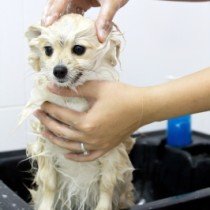
Every time a flea bites, it leaves behind saliva that irritates the bite, often causing an allergic reaction. The resulting dermatitis is very uncomfortable for your little dog and can lead to infection…
Fleas can bite dozens of times an hour or more, they feed on a tiny bit of blood with every bite, so puppies can become anemic with a large enough infestation. These bugs also spread nasty parasites, including one variety of tapeworm. Luckily, with proper care, fleas won’t be a bother. You just have to know what to do.
Contents
How To Check Your Puppy For Fleas
You won’t always notice fleas unless you look closely. A dog that is very itchy, particularly around its back end, may be infested. If your pup is scratching and biting around his flanks, take a close look at the skin under his fur. Fleas tend to bite around the dog’s hindquarters and around the face and ears. Bites will be easily visible on the lower belly where the hair is short and thinner.
Beneath thick coats they can be hard to see sometimes, but fleas will be visible as tiny hopping insects, a little bit bigger than the period at the end of this sentence. They will also leave behind “flea dirt”, white/brown flakey residue, and red bite marks. “Flea dirt” turns red if it touches water, so try this if you’re unsure.
Combing your pup on a white towel will catch flea dirt for further visual inspection. Run a flea comb through the hair and you will see fleas caught in the teeth of the comb. Checking for fleas should be a routine part of combing your puppy. If caught early, a flea infestation won’t get out of control.
Treatment And Prevention
Young puppies
If you have a very young puppy (younger than 8 weeks) a bath in warm water mixed with Dawn detergent is a very effective treatment against fleas. This soap kills fleas quickly and you will have only to pick the leftover bugs off with tweezers.
Dawn is safe to use on puppies (just keep it out of their eyes) and is used by many breeders. Take care using “natural” flea treatments for tiny puppies because they can be dangerous for the young ones.
Puppies older than 8 weeks
If your puppy is 8 weeks or older there are great products available that will make flea bites a thing of the past. They are long-lasting, working up to 7 months when applied directly to the skin or are maintained with a monthly pill.
- WATERPROOF FLEA AND TICK TREATMENT FOR DOGS: Frontline Plus for Dogs provides waterproof, fast-acting, long-lasting flea and tick treatment and control for your...
- BREAK THE FLEA LIFE CYCLE WITH FRONTLINE: Frontline flea and tick treatment for dogs kills adult fleas plus flea eggs and larvae to stop existing infestations...
Last update on 2019-01-04 / Affiliate links / Images from Amazon Product Advertising API
Modern flea preventers include IGRs (insect growth regulators). IGRs are chemicals that don’t harm your precious pup but do significant damage to fleas. Some IGRs keep flea larvae from maturing. Others sterilize adults to prevent reproduction. Most will also kill current infestations. Through a combination of these effects, fleas will quickly be history.
- Flea & Tick Supplies
Last update on 2019-01-04 / Affiliate links / Images from Amazon Product Advertising API
Top-spot puppy flea treatment comes in small tubes and are applied to a puppy’s neck area, between the shoulder blades. This is a spot where the drug can do its work without a curious puppy licking it off. Drugs like Advantage and Frontline mix with the oils on a dog’s skin,
providing a barrier against fleas. Revolution mixes with a puppy’s bloodstream for another very effective treatment. These medications kill adult fleas and prevent future generations with IGRs.
Excellent treatments like Frontline Plus are also effective against ticks. Combination flea and tick treatments will feature some combination of the drugs fipronil, methoprene, Nylar, and/or etofenprox.
Your vet will have all the information you need to pick out the right treatment for these pests. If you choose an over-the-counter flea treatment, closely follow the instructions on the label. These medications are essential when fighting to win the bug wars!
It is important not to forget the most important line of defense, a flea-proof house. Once your pup gets fleas, they start to reproduce prolifically. After your dog is de-flead, wash all of her bedding thoroughly to get rid of any stragglers and their eggs. Next vacuum everything in your house. Any crevice can be a haven for fleas and their spawn.
A last method is using a dehumidifier or two to dry out the air to the point where fleas cannot survive. Anything below 50% humidity will work do the trick in one or two days. Keeping the house clean and your puppy treated should keep your domicile flee free.

I have lived in big cities my entire life. Having grown up on the Upper East Side in Manhattan, my early life was an exciting one, filled to the brim with interesting encounters and opportunities popping up at every street corner. Like many city people, my passion for dogs first started when my parents decided to bring a puppy into the household. For them, it was a way of getting me to spend less time at his computer or wandering aimlessly around the city with my friends. Little did they know that bringing a Labrador Retriever into their apartment would determine not only the course of their son’s professional career but also my love life.
Having obtained a Computer Science Bachelor’s degree from Fordham University, I went on to pursue an IT career in the Big Apple. After a few years of doing basic cybersecurity and tech support work in various offices around Manhattan, I decided to leave New York and look for my calling in Boston, Massachusetts. There, I got a Master’s degree in Computer Science with a specialization in Web Development. As a means of supporting myself through college, he found a salesman job at a local paper company, where he met Mary, the love of my life and the person I’d end up creating My Sweet Puppy with.



![[HOW TO] Get Rid Of Puppy Worms Today](https://mysweetpuppy.net/wp-content/uploads/2020/09/How-much-should-I-feed-my-8-week-old-lab-puppy.jpg)


Thanks for connecting to Mysweetpuppy.net. Please keep in mind that I, Claudia Bensimoun, do not write any of the blogs or reviews on this website, nor have I in the past. I only answer the comments section.
What are natural flea treatments?
I am in no way connected to the content written within this website, most especially the German Shepherd blog. This website hires other writers for their blogs.Please do not contact me regarding website content. I only write content within the comments section.
I am in no way connected to the content written within this website, most especially the German Shepherd blog. This website hires other writers for their blogs.Please do not contact me regarding website content. I only write content within the comments section.
We all want for our dogs to live longer and healthier lives! That said,Banfield Pet Hospital® released its 2018 State of Pet Health® Report, which explores the science behind skin allergies in pets and sheds light on flea, environmental and food allergies.
Key findings from Banfield’s 2018 State of Pet Health Report include:
“Flea Allergies. Fleas are the most common external parasite Banfield sees on its patients. According to Banfield data, cats are twice as likely as dogs to be found with fleas; however, fleas exist in all types of weather, on outdoor and indoor pets and in all 50 states – all year long. Therefore, year-round prevention with veterinarian-approved medication is key.” via Banfield Pet Hospital
How to Go Green With Flea Products?
With the emphasis being on the importance of feeding high-quality diets, pet parents need to also consider eco-friendly and green products for their pooches. Products like BugPellent Fly & Tick Gel repels close to 83% of ticks, working naturally year round. Fleas can transmit diseases, and may cause anemia in dogs. They also cause endless itching, due to severe irritation. Flea allergy dermatitis occurs when dogs are allergic to flea saliva, and intense itching occurs. That said, most dogs will itch from flea bites, regardless of whether they’re allergic or not. Allergic dogs will also lick and scratch. This may be accompanied by pacing, and biting of the affected area. Fleas leads to hair loss, hot spots, scabbing, crusting, and secondary infections. It’s always important to consult with your veterinarian as soon as this occurs, because secondary skin affections from flea bites may lead to anemia in young pups. Even though flea allergy dermatitis tends to occur mostly in the summer, it can take place any time of year in some places like Florida. Your veterinarian may do skin testing, so as to eliminate food or other allergies. Respiratory allergies, and other skin parasites infestations will also cause skin inflammation and irritation in dogs.
The most effective flea treatment is one that your veterinarian prescribes, and that works best for your pooch. Veterinarians sell flea treatments, and will be able to discuss all flea treatment options with you. It may also be necessary to eliminate fleas from your dog’s bed, home, and other places that he or she frequents.
A study published in Plos One adds that “Dogs are the main reservoir hosts of Leishmania infantum, the agent of human zoonotic visceral leishmaniosis. This study investigated the efficacy of a polymer matrix collar containing a combination of 10% imidacloprid and 4.5% flumethrin as a novel prophylactic measure to prevent L. infantum infections in young dogs from a hyper-endemic area of southern Italy, with a view towards enhancing current control strategies against both human and canine leishmaniosis.” via Plos One.
“Leishmania infantum is a major protozoan parasite transmitted by arthropod vectors causing visceral and cutaneous leishmaniosis in dogs and humans in southern Europe, Africa, Middle and Far Eastern countries and Central and South America, with approximately 500,000 new infections recorded each year. In southern Europe (including Turkey), leishmaniosis caused by L. infantum is endemic, with a total of 3,950 new human cases reported each year. Dogs play a major role as the main reservoir hosts of zoonotic visceral leishmaniosis . Indeed, canine leishmaniosis (CanL) is amongst the most widespread vector-borne parasitic diseases affecting dogs from all continents.”
The study concludes “The present study reports the results of the first large-scale investigation of the efficacy of a combination of 10% imidacloprid and 4.5% flumethrin in a collar formulation for the prevention of one of the most important arthropod-borne, zoonotic diseases of dogs worldwide. This combination proved safe and 100% efficacious in preventing L. infantum infection in young dogs after their first exposure to the aetiological agent of CanL in a hyper-endemic area. Dogs were treated according to their increasing bodyweight and collars were replaced.
The results from the present study indicate that the use of 10% imidacloprid and 4.5% flumethrin in collar formulation offers long-term (i.e., up to 8 months), reliable and sustainable protection against L. infantum infection in hyper-endemic areas. The widespread use of this effective prophylactic measure, combined with additional control strategies directed towards the reduction of the L. infantum infection in the sand fly populations in the same areas will ultimately assist in the elimination of the risks for the canine and human populations alike. ” via University of Australia, Plos One.
Pharmaceutical flea options are controversial, but if you’re opting for more natural treatments, consider the following products:
.diatomaceous earth
.apple cider vinegar
.essential oils
.vitamin B supplements
.flea comb
.Vet’s Best Dog Flea and Tick Home Spray ( plant- based formula)
.Organic citronella and lemongrass products
.Tropiclean Natural Flea and Tick Home Spray
.Natural Care Flea and Tick Spray
.Wondercide Flea and Tick Control
What to Look for in a Natural Flea Product?
. No artificial colors
. biodegradable and recycle packaging that is safe for the environment
. green America label that certifies high standards for being eco-friendly
. cruelty-free product
Products with cedarwood oil may allow for the natural elimination of fleas and ticks. Cedarwood is also beneficial in calming and soothing skin. Lemongrass oil may also be beneficial in deterring and killing pests. It helps to revitalize and restore. Rosemary oil relaxes and restores, while killing fleas and ticks. Rosemary oil helps as well, and has relaxing and restoring qualities. Coconut oil may help to repel fleas and ticks, although it’s great for healing, and maintaining both skin and coat condition in dogs.
Natural or alternative flea preventatives will have varying degrees of success.
For more about the wonders of Rooibos tea and dogs, visit:https://animalwellnessmagazine.com/rooibos-tea-a-healing-brew-for-you-and-your-dog/
For more on my article about cruelty-free cosmetics and interview with PETA, visit:https://www.fidofriendly.com/article/cruelty-free-cosmetics
Thanks for connecting to Mysweetpuppy.net. Please keep in mind that I, Claudia Bensimoun, do not write any of the blogs or reviews on this website, nor have I in the past. I only answer the comments section.